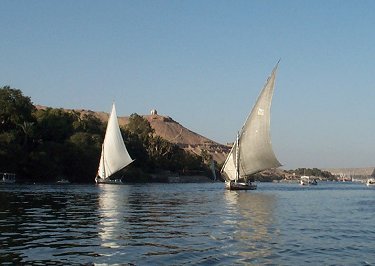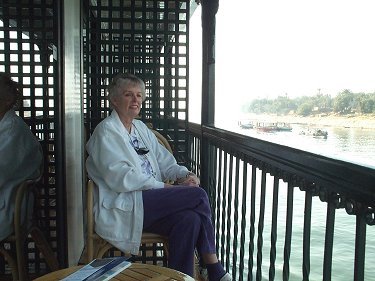We stayed in Luxor a couple of days and used the boat as our hotel. So now were up to February 2nd and today it's the Valley of the Kings. The procedure is a little bit stranger here. First you buy a ticket to visit 3 tombs as well as 3 tickets for your camera. They rotate the tombs you can visit so you never know for sure what tombs will be open. Next you buy a ticket for Tutankhamun's tomb (no cameras). Next you buy a ticket for Queen Nefertari's Tomb (no cameras), for which they only sell 150 tickets a day, this is all done at a central ticket booth. Now you're all set and you can go to the Valley, except when you get there there's a whole bunch of people there ahead of you, long lines waiting for this little Disneyland type tram to take you up into the valley. I think our tour guide bribed the tram driver and got our group up to the head of the line, bless her heart. The picture on the right is the entrance to King Tut's Tomb. Most all of the explanations at the tombs and also at the museums were in just two languages, Arabic and English.
The prices are 20 pounds first ticket, 40 pounds second ticket, and 100 pounds third ticket. Cameras cost 5 pounds each tomb. The rate of exchange was about 4.5 pounds to the dollar. Tickets for video cameras were a great deal more, maybe 10 to 20 times as much. Queen Nefertari's tomb was worth twice what we paid for the ticket. It was wonderful. The Egyptian people got a break on the price of most tickets because tourism was down, they were trying to get their own people to fill the gap and it was working, or so it seemed, or maybe it was just because of the holiday.

On our way back to the boat we stopped briefly to take pictures at Queen Hatshepsut's temple, the only female pharaoh. We didn't go in. The other picture was taken a couple of days earlier showing the ladies lined up at the WC.
After the Valley of the Kings, Queen's, and Nobel's, we saw Karnak. It was one of the more popular attractions, especially for the Egyptians.
Now we start traveling up the Nile toward Aswan


The next temple was at Edfu. The Temple of Horus.
That night we went to the Temple of Kom Ombo dedicated to the God Sobek, the crocodile God. Those pictures were too dark to show. The next day, we took a boat ride to the Philae Temple which was relocated to an island because of the Aswan Dam.
And as we went further south toward the dam the weather got warmer, the people got darker, and we were approaching the end of the adventure. But they saved the best till last, the Temples of Abu Simbel. These are the ones which were saved from the rising water by moving them 200 feet higher on the hill, a project that took 7 years. These statues of Ramses II and Queen Nefertari are enormous, 67 feet high. Second picture is on the Aswan High Dam.
Now a few pictures of the folks that were on the trip with us, although some were camera shy.
Basma
Fred Reimers
Jean and Ken Butler John and Leslie O'BrienThis is the end of the trip so don't look any further.
Warren Maichel And his sister Ruth MaichelEgypt Page One Home Page Page updated Feb. 21, 2002